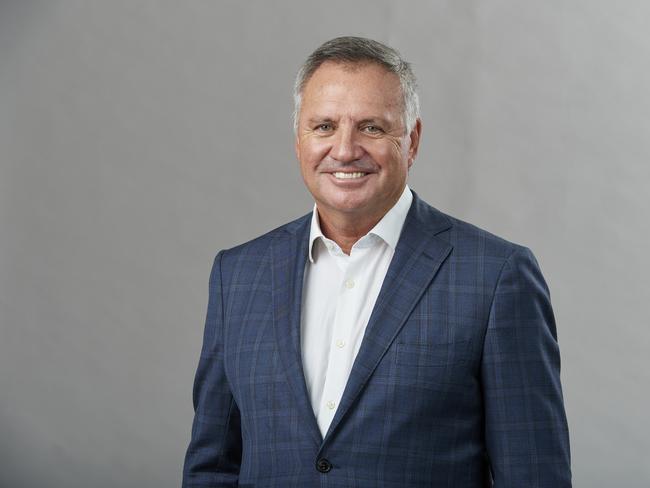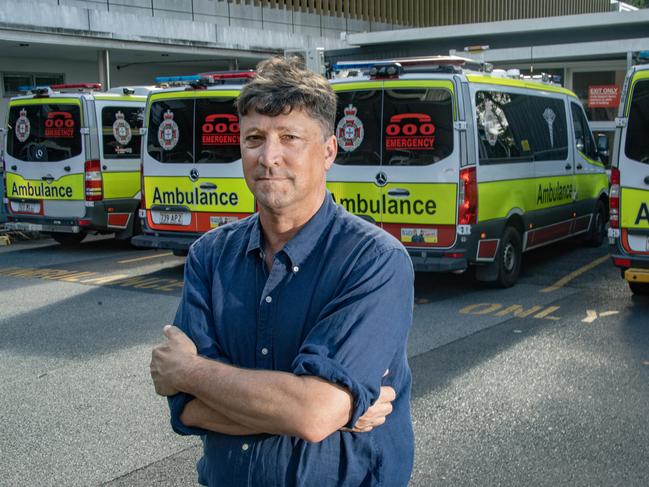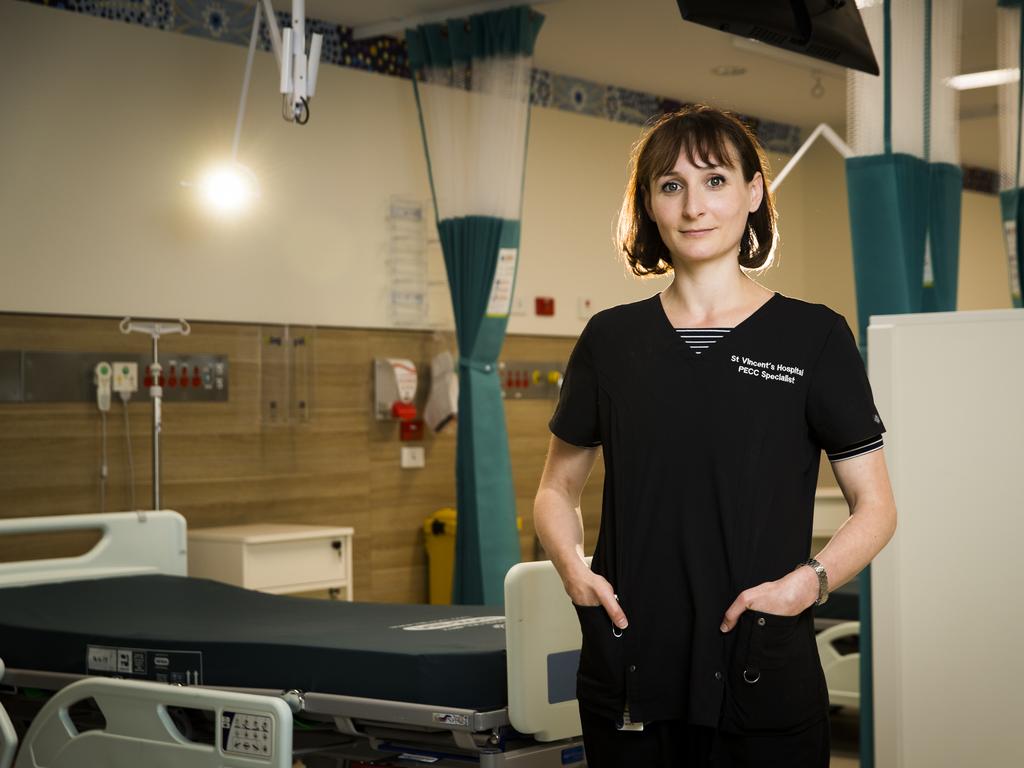Perilous disconnect between hospital doctors and bosses
Raising issues of patient safety or governance at public hospitals means risking becoming a target.

In an immortal scene from Yes Minister, Jim Hacker is escorted by administrators through a new empty hospital. St Edward’s Hospital has 500 administrators and no patients. As Hacker is shown around a new theatre, he asks whether it is not appalling that it is not being used.
“Oh no,” says hospital chief Mrs Rogers. “A very good thing, in many ways. Prolongs its life. Cuts down running costs.”
“But there are no patients!” Hacker protests.
“No, but the essential work of the hospital still has to go on,” says Mrs Rogers. “Running an organisation of 500 is a big job, minister.”
There were echoes of Yes Minister during an announcement in April of a new $540m mental health facility to be built at Sydney’s Westmead Hospital in its new multi-level building.
The 250-bed facility was announced with fanfare as the NSW mental health system is operating on threadbare staffing. Almost half of the workforce of senior staff specialists have resigned in an extraordinary case of doctors becoming unwilling, en masse, to work in a dysfunctional system.
The new Westmead wing has not been slated with any imminent increase or rehiring of staff specialists, similar to two new theatres at the nearby Children’s Hospital at Westmead that are unable to be used for a large chunk of the week because of staff shortages. In the eyes of health administrators and ministers, new buildings and theatres apparently can function with no increase in staff.
The maths do not add up. But measurement of such absurdity is not factored into the simple arithmetic of publicly reported key performance indicators, so it hardly matters. Cutting ribbons on new buildings is political catnip to state governments.
Those governments seem disturbingly impervious to the deep sense of malaise widely felt by doctors and nurses within public hospitals. Morale has never been so low and never have these staff felt so undervalued and disrespected.
The pandemic heaped pressure on health systems and ground staff down, with many now able to stomach working only part time or contemplating leaving the public system altogether.
The rate of registrars staying in the public system after training is declining precipitously.
But it’s not only the pressures on public hospitals and post-pandemic exhaustion that are driving staff to the wall. It’s something much more pernicious. It’s more than a widespread sense of fundamental disrespect and powerlessness in the face of responsibility.
It’s that hospitals have become unsafe cultures, dangerous places where raising issues of patient safety or clinical governance is to risk becoming the target yourself. It happens time and time again, too frequently to be regarded as anything but a system-wide perversion of proper leadership.
“I think over the past 25 years there has been a steady alienation of the medical profession,” says Steve Bolsin, a British anaesthetist who exposed incompetent pediatric cardiac surgery at the Bristol Royal Infirmary, which led to the birth of clinical governance reforms in Britain’s National Health Service.
“There has been a rising culture of managerialism, and the power that management has been able to wield over what had previously been seen as a fairly independent medical profession has often been used to wage personality wars against people who speak out on behalf of patients for patient safety. They are too often picked on by management through what is now a burdensome and probably punitive system of clinical governance.
“And there is no evidence that there had been a reduction in incidence of adverse events in hospitals. There has been absolutely no decline in patient safety incidents reported, despite the fact that the hospitals have all been implementing patient safety programs and clinical governance committees.
“I think that the sort of primary goal of most organisations is to balance the budget rather than to provide high-quality care.
“I think it’s true that hospital managements today have lost sight of the patient.”
During the past three weeks, The Australian’s Life Support series has documented devastating trends in medicine. Some of the most talented and skilled doctors and nurses are walking away from public hospitals amid what is being described as a widespread culture of cover-up and payback in health systems across the country.
A national survey by the Australian Salaried Medical Officers Federation released in April found doctors who reported concerns about safety or adverse workplace issues were routinely subject to retribution by health service managers or administrators.
Doctors across the gamut of specialties described what they said was a profound disconnect between health administrators and clinicians who widely reported being reluctant or even terrified to raise issues of patient safety or other threats to good clinical care lest they be subject to retaliatory investigation processes.
The survey found about a third of doctors who raised concerns subsequently were accused of misconduct or insubordination; only 25 per cent felt they were treated with respect by their hospital administrators and managers; and only 40 per cent said they were highly likely to remain in the public health system during the next five years.
The revelations have prompted a call to arms by the Australasian College of Health Service Management, which represents health administrators and which is urging a shift from blame to “bold, collaborative, clinician-informed leadership”.
“We cannot afford to frame this as a battle between doctors and managers,” ACHSM president Neale Fong says. “This is not a war between opposing forces; it’s a team under pressure trying to land the same storm-battered plane.

“These are structural issues. We’re not interested in scapegoating individuals, we’re interested in reforming systems that are reactive, politicised and disconnected from long-term health outcomes.”
Across the country, the trends highlighted in the ASMOF national survey at times spill out into public arena.
For the past two years the Sydney Local Health District has been racked by controversy as doctors rebelled against longstanding idiosyncratic resourcing and a culture of nepotism amid claims the health district had been run like an autocracy.
In South Australia, senior emergency department physician Megan Brooks made the extraordinary claim before a parliamentary committee that she was threatened by the state’s Attorney-General that she might face investigation for misconduct if she gave evidence to a coronial hearing into the deaths of three patients who had been ramped in ambulances outside the Royal Adelaide Hospital. The hospital had earlier declined to investigate one of the deaths.
“It was deeply upsetting to have my motivations questioned and to say that I somehow had an agenda to embarrass the state or something similar to that,” Brooks told the Select Committee on Health Services in South Australia in March. “I have only ever sought to be a good representative of clinicians and try to have good outcomes for my patients.”
In Perth, junior doctors who treated three-year-old Aliyah Yugovich, who was wrongly administered an anti-seizure drug before she died with the flu at Perth Children’s Hospital, were reported to the medical regulator by executives.
But hospital management has faced no scrutiny of its own actions in the running of the hospital and the structural factors that may have led to the disaster.
“The organism of management is designed to protect itself,” West Australian anaesthetist and former state AMA president Andrew Miller says. “There are very strict governance processes in place for junior staff and for clinical staff, but not for administration and management, so when something goes wrong there’s not the same degree of examination of why the system is under-resourced.
“In the last 30 years that I’ve been involved in healthcare, we’ve seen a move from generally a robust but goodwill relationship between management and clinical staff, more towards an authoritarian style of management and a reduction in power of clinical staff.
“It’s not to say that all administrators are bad. Of course, that would be a caricature. There’s a lot of very good people in administration, but the way the system is structured, there’s lip service paid that patient safety comes first, whereas, in fact it is the budget that comes first within hospitals.”
Across the past 25 years, clinician-led management has been replaced in hospitals with governance by professional administrators. Some are doctors but many are not. Doctors now complain that administrators frequently display a profound lack of understanding of their frontline work and that an obsession with risk-management procedures has become a tick-box culture that does not benefit patients and takes time away from the bedside. It also stifles innovation.
Anthony Porter is a publicly employed clinician in South Australia and is involved in research into the use of artificial intelligence in healthcare. He says that whereas many public sector doctors previously devoted part of their time to contributing to research, many have given that up and taken a “quiet quitting” approach.
“It’s an autocracy that hospital administrators are running now,” Porter says. “It’s extremely anti-democratic. Really, the leadership has cut itself off from the doctors. Because of that, they tend to treat the staff as resources rather than as something valuable to build. Their main things that they’re looking at are how to achieve efficiencies.
“There’s no visionary leadership in health, only absolutely none at all.
“If you ask doctors and nurses, how much say do they have in the running of a hospital, they say next to nothing. And so that’s where the moral crumple zone is, where the 50 per cent running the whole show is completely independent of the people who are out the front, who have to sort of justify the way that the hospital is being run.
“Most of the time people just end up apologising to patients for the way that it is.”
The undermining of the skill and respect for clinicians goes wider than public hospitals. It’s also playing out in national policy that circumvents the role of medical colleges in vetting international medical graduates, as well as scope of practice reforms across several areas from pharmacy to nursing to physiotherapy.
This is despite evidence that scope of practice creep has been ineffective in Britain.
A study published in the British Medical Journal in March found no convincing evidence that physician associates added value in British primary care or anaesthetics. PAs undergo two years of postgraduate training and can take medical histories, perform examinations, order and interpret tests, and manage some conditions.
The British Medical Association GP committee recently voted to end the hiring of PAs in general practice, with many members deeming their practice “fundamentally unsafe”.
“I do think medical leadership is under threat at the moment,” says David Story, president of the Australian and New Zealand College of Anaesthetists. “The last thing we want is fractured care.
“If you look at a number of the reports running around at the moment, you look at the Kruk review of regulatory settings, Robyn Kruk is a non-medical public servant. You’ve got the scope of practice review by Mark Cormack, who is a business person, and the Medical Board carrying out government instructions. You’ve got the National Health Practitioner Ombudsman, who is a lawyer, who’s playing in a whole range of areas at the moment, including a new report around international medical graduates and accreditation. The view of many of the colleges, including my own, is that the ombudsman’s role has been weaponised. It has almost been weaponised to attack the colleges.

“This is all happening despite scope of practice creep going incredibly badly in the UK, with patients misunderstanding the role of people with very limited training.”
Ken Hillman, who worked as an intensive care physician in public hospitals for 40 years and is now professor of intensive care at the school of clinical medicine at the University of NSW, says policies that disempower doctors create a vicious circle that result in clinicians abandoning the system and precipitating a greater reliance on stopgap measures.
This has been seen in the psychiatry crisis in NSW in which psychologists and social workers are being asked to fill the gaps left by doctors, with tacit encouragement from the health ministry. Rather than listen to desperate attempts to raise the alarm that mental health systems are critically overstretched and unsafe for patients, governments have chosen to let doctors who were passionately committed to the public system walk away and rely on adapted models of care.

“I think the danger here is that we will all turn into psychiatrists,” Hillman says. “Their job satisfaction was becoming less than zero. In many other parts of the health system we still see the positives despite the system. Whereas I think if you look at the psychiatrists, I think that’s where the system could go for a lot of people.
“What we need is a system where more attention is paid to the whistleblowers, where these concerned clinicians are not seen as troublemakers or threats but as opportunities. We have an opportunity to improve patient care.
“I’d say that on the whole the health system is still functioning well, but it is functioning well at the cost of the people that are supporting it.”







To join the conversation, please log in. Don't have an account? Register
Join the conversation, you are commenting as Logout